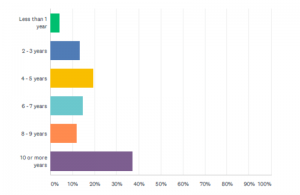Behavioural targeting has long been the default targeting method on a marketer’s programmatic campaign checklist. Since the 1990s, the cookie has made tracking in-browser user behaviour a useful tool for targeting digital ads towards receptive consumers. But with consumer demand and new regulations around online privacy, this is changing—which means it’s time to consider targeting methods like contextual advertising.
Many browsers are phasing out 3rd-party cookie tracking. For example, a recent Google announcement shared that it will phase out the 3rd-party cookie on Chrome browsers by 2022. This means that behavioural advertising will be more restricted in the coming years. Marketers will need to adjust by embracing new targeting methodologies, like contextual targeting.
To prepare you for these upcoming changes, we’ll explain the benefits of both targeting methods, when they should be considered and how they can be leveraged for the best campaign performance results.
Behavioural Targeting vs. Contextual Targeting
Before exploring the benefits of contextual targeting, let’s review the basics of both behavioural and contextual.
What is Behavioural Advertising
Behavioural targeting, often referred to as audience targeting, aims to ensure that an ad is relevant to the user who is visiting a page. This is done by serving ads based on a user’s web-browsing behaviour. User data is collected from various sources, and typically to collect this data you need some sort of user identifier, like a pixel or cookie.
Data collected from pixels is stored in a data management platform (DMP) or in a programmatic advertising or demand-side platform (DSP). Some of the data will include information about page visits, ad clicks, or time spent on particular content. This data is then analyzed and used to create targetable audiences that represent shopping and search habits. For example, if a user has been clicking on ads for espresso makers, then it can be established that the user is interested in this product.
Behavioural targeting relies on the user’s past actions to understand the kind of purchase they are likely to make. If a user performs an action, whether online or offline, will enter a user pool or audience list. A cookie or online identifier is needed to track this user—then, ads can be served to the group of users.
The benefit of behavioural targeting is that you can ensure your ad is relevant to the user who is viewing it, essentially ignoring the content of the page on which the ad appears. This targeting method has been widely used in online advertising for over 10 years. And as the collection of user data has become more advanced, so have the capabilities of behavioural targeting.
What is Contextual Advertising
Rather than targeting ads based on user behaviour, contextual advertising targets ads based on the environment in which the ad appears. This targeting method uses algorithms to target ad placements based on keywords, website content, and other metadata. This way, ads are shown to users based on the content they are consuming at that moment in time.
The key difference between contextual and behavioural advertising is that behavioural targeting aims to ensure the ad is relevant to the user, largely ignoring the content next to which the ad appears. Whereas behavioural advertising targets based on a user’s past actions, contextual advertising targets based on the content of the page on which the advertisement appears. In this way, contextual advertising is essentially targeting users while they have a particular frame of mind, the frame of mind of consuming that specific content. For example, if a user is reading a blog about coffee, they could be served ads for coffee beans, or coffee makers, as it’s likely at that time the user is thinking about coffee-related products.
Contextual Advertising Effectiveness
Some marketers might think the switch to contextual advertising is necessary only because the pixel is phasing out. While that alone is reason enough to embrace it, the unique approach to targeting that contextual advertising offers has other benefits, too. By taking advantage of these benefits, you might see your return on ad spend (ROAS) improve!
Here are 4 reasons why contextual targeting is both effective and beneficial:
1. This targeting tactic allows you to reach users when they are in a receptive frame of mind. When a person is browsing content about a specific topic, it signals their intent at that moment. Instead of targeting based on their past actions, they are targeted based on their immediate frame of mind.
2. Contextual targeting isn’t constrained by privacy legislation. Because it doesn’t collect or use information about users, it protects user privacy. Instead, it leverages the context next to which the ad appears.
3. If your DSP offers an advanced contextual advertising solution, it will provide an opportunity to target niche contexts. You can choose to target by a general topic, or you can use a collection of phrases for more precise targeting. Instead of targeting “coffee,” you can use input phrases like “organic coffee beans”, “organic coffee”, and “dark beans” to narrow the context even further.
4. Since contextual advertising campaigns are served programmatically, you can review real-time metrics and optimize for maximum performance. Your DSP should allow you to verify your ads served on relevant domains pre- and in-flight. This gives you the ability to revise your selected topics and phrases in real-time to improve the performance of your campaigns.
How Contextual Advertising Works
We’ve covered the differences between behavioural and contextual advertising and the benefits of contextual. But how does contextual advertising actually work? Let’s dig into the basic process for contextual ad placement.
If your DSP offers contextual advertising, the platform will do the heavy lifting of placing your ad on web pages that meet your targeting parameters. Once you have your creative all set to go, you’ll set up your custom contextual strategy.
Here’s an example of how it works: in the campaign setup, identify in context and out of context phrases, then the algorithm will determine the best ad placements based on the site content. An algorithm will then determine the best ad placements based on a publisher or site’s content. With artificial intelligence (AI), targeting can be expanded further to include relevant phrases that are related to the context.
An important nuance to note is that the best context isn’t always the same as a campaign’s landing page. When advertising vacations to Florida, the right keywords should hone in on the mindset of someone who would be receptive to the idea of a vacation and warm weather. In this case, targeting phrases related to bad weather could capture the right user intent for the campaign.
Once you’ve input your in context and out of context phrases, you can set your campaign live. The DSP uses an algorithm to analyze the content in each display network web page to try to match your ad with the most relevant content. The ad is served when a placement that matches your parameters is found.
How to Balance Contextual Advertising with Behavioural Advertising
The cookie isn’t entirely phased out yet. This means that for now, many advertisers are continuing with their well established behavioural strategies. We understand—it’s comfortable to stick to what you know! But since we’re in a transitional moment, now’s the time to consider how to introduce contextual into your existing strategy.
This doesn’t mean abandoning your behavioural campaigns right away. Instead, strike a balance between these methodologies so that you can slowly introduce contextual tactics. Blending both methodologies will make for a well-rounded strategy, and help you to gain more confidence in running contextual campaigns. Rather than waiting until legislation makes the use of cookies unavailable, get ahead of the curve by embracing contextual advertising now.
Introducing Contextual Advertising to Your Digital Strategy
Contextual advertising departs from the traditional behavioural approach of making sure ads are relevant to a user. Instead, a contextual targeting approach aims to ensure the ad is relevant to the content of that page. And as the advertising industry continues to move toward a cookie-less world, the role of contextual will continue to grow. With this, comes plenty of new opportunities!
Digital & Social Articles on Business 2 Community
(57)
Report Post


